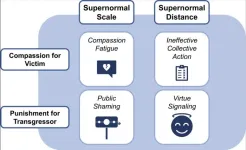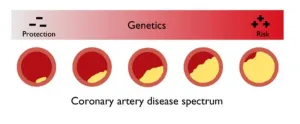(Press-News.org) The toxic gas ethylene oxide, at levels thousand times higher than what is considered safe, was detected across parts of Louisiana with a cutting-edge mobile air-testing lab. The concentrations found dwarfed Environmental Protection Agency estimates for the region.
The findings, led by Johns Hopkins University environmental engineers, suggest significantly higher cancer risks for people who live near facilities that manufacture and use ethylene oxide, as well as a need for more accurate and reliable tools to monitor emissions.
“I don’t think there’s any census track in the area that wasn’t at higher risk for cancer than we would deem acceptable,” said senior author Peter DeCarlo, an associate professor of Environmental Health and Engineering who studies air quality. “We expected to see ethylene oxide in this area. But we didn’t expect the levels that we saw, and they certainly were much, much higher than EPA’s estimated levels.”
The work is newly published in Environmental Science & Technology.
Ethylene oxide is a man-made gas commonly used to manufacture other chemicals, to fumigate, and to sterilize medical and food production equipment. It’s very dangerous to humans, even at low concentrations, with inhalation being the primary route of exposure. Long-term ethylene oxide exposure has been linked to cancer—often for people who live near facilities that manufacture it or work with it.
The gas is difficult to detect or measure in the air through traditional monitoring methods that attempt to collect samples on site and bring them back to a lab for analysis. Studies have shown that the compound concentrations change over time so traditional measurement techniques are unlikely to reflect how much gas people living near testing sites are exposed to.
“There is just no available data, no actual measurements of ethylene oxide in air, to inform workers and people who live nearby what their actual risk is based on their exposure to this chemical,” DeCarlo said.
Although facilities everywhere work with ethylene oxide, these facilities are large and concentrated in southeastern Louisiana, where there is a history of significant environmental injustices related to exposures to toxic chemicals—the area has become known as “Cancer Alley.”
The researchers devised a way to directly measure ethylene oxide in the air at these facilities—a mobile lab.
“We went out to answer the question: how much ethylene oxide is in the air in this region and are the levels of concern for people’s health?” said lead author Ellis Robinson, an assistant research engineer at Johns Hopkins. “Making it happen involved putting cutting-edge analytical equipment in a giant mobile laboratory that we could drive all around, analyzing data for about a month.”
The mobile lab consisted of two vans, each equipped with different but highly sensitive technologies to measure ethylene oxide in real time. During winter 2023, the team repeatedly looped along a heavily industrialized route between New Orleans and Baton Rouge Mississippi River, collecting air and testing it as they drove past large industrial facilities and also many residential areas, some quite close to the plants.
“By driving the same route, over and over and over again at different times of day over the over the course of an entire month we were able to build up statistics and get average concentrations throughout the region,” DeCarlo said. “The two testing methods agreed really well and provided us with confidence in measurements that we took.”
Ethylene oxide is so toxic, red flag levels for long term exposure and human health start at anything over 11 parts per trillion. The team found levels as high as 40 parts per billion in spots closed to industrial facilities. They were also able to follow air flow and detected concerning amounts of the gas as much as 10 kilometers downwind from the plants.
“We’d drive through the industrial areas and saw concentrations hitting 40 parts per billion, which is more a thousand times higher than the accepted risk for lifetime exposure,” DeCarlo said.
When the team compared their measurements with those able to be detected with the EPA’s current screening tools, their own measurements were significantly higher, translating to much greater risks for cancer for the nearby communities.
“Our findings have really important implications for community residents, especially infants and children,” said Keeve Nachman, associate professor of Environmental Health and Engineering and the co-director of the Risk Sciences and Public Policy Institute. “Ethylene oxide has been shown to directly damage DNA, meaning that exposures that occur in early life are more dangerous.”
The EPA just announced stricter rules on ethylene oxide that would require commercial sterilizing outfits to dramatically reduce emissions. The findings here could help regulators identify and more tightly monitor hot spots.
Our study demonstrates the need for more accurate measurements to help identify locations to install monitors for more long-term monitoring and so we can best protect the health of people who are living in those areas,” DeCarlo said
Authors include: Mina Tehrani, Amira Yassine, Shivang Agarwal, Carolyn Gigot, Andrea Chiger, Sara Lupolt, Benjamin A Nault, Kirsten Koehler, Ana Rule, Thomas Burke, and Keeve Nachman, all from Johns Hopkins; Tara Yacovitch, Conner Daube, Anita Avery, Megan Claflin, Harald Stark, Elizabeth Lunny, Joseph Roscioli, Scott and Herndon, all of Aerodyne Research Inc.; and Kai Skog and Jonathan Bent of Picarro Inc.
END
Surprisingly high levels of toxic gas found in Louisiana
Soaring ethylene oxide level detected, threatening children’s health
2024-06-11
ELSE PRESS RELEASES FROM THIS DATE:
Soil bacteria respire more CO2 after sugar-free meals
2024-06-11
When soil microbes eat plant matter, the digested food follows one of two pathways. Either the microbe uses the food to build its own body, or it respires its meal as carbon dioxide (CO2) into the atmosphere.
Now, a Northwestern University-led research team has, for the first time, tracked the pathways of a mixture of plant waste as it moves through bacteria’s metabolism to contribute to atmospheric CO2. The researchers discovered that microbes respire three times as much CO2 from lignin carbons (non-sugar aromatic units) compared to cellulose carbons (glucose sugar units), which both add structure and support ...
Human evolution and online morality
2024-06-11
In a Review article, Claire Robertson and colleagues explore how human morality, which evolved in the context of small in-person groups, functions on the internet with over five billion users. Evolved human responses, such as compassion for victims and urges to punish transgressors, operate differently online, the authors argue. The internet exposes users to large quantities of extreme morally relevant stimuli in the form of 24-hour news and intentionally outrageous content from sometimes physically distant locations. Subjecting human brains to this ...
Price sensitivity to unhealthy foods
2024-06-11
Consumer data shows people with obesity are more price-sensitive than others when it comes to buying unhealthy foods, suggesting a food tax could be an effective public health measure. Taxes on sugar-sweetened beverages have become a commonly employed policy to improve public health. Less common are taxes on unhealthy foods, such as candy, cookies, or potato chips--and there is little data on whether such taxes would improve public health. Ying Bao and colleagues examined whether individuals of various ...
Book bans as political action
2024-06-11
In the 2021–2022 school year, schools banned books more often than ever before in United States history. Katie Spoon, Isabelle Langrock, and colleagues analyzed data from PEN America on 2,532 book bans that occurred during the year, in combination with county-level administrative data, book sales data, and a novel crowd-sourced dataset of author demographic information. The research team found that people of color are several times more likely to be the authors of banned books than White authors and that a considerable proportion of banned books, both fictional and historical, feature characters of color. About 37% of banned books were children’s ...
New study shows metabolic and bariatric surgery prevents pre-diabetes from developing into type 2 diabetes in most patients
2024-06-11
Patients with pre-diabetes and severe obesity who had metabolic and bariatric surgery were 20-times less likely to develop full-blown type 2 diabetes over the course of 15 years than patients with the condition who did not have surgery, according to a new study* presented today at the American Society for Metabolic and Bariatric Surgery (ASMBS) 2024 Annual Scientific Meeting.
Only 1.8% of patients progressed to a diagnosis of diabetes in five years after metabolic surgery (Roux-en-Y gastric bypass or sleeve gastrectomy), which rose to 3.3% in 10 years and 6.7% after 15 years. The protective effect against diabetes was higher ...
New studies suggest benefit of total robotic metabolic and bariatric surgery over conventional laparoscopy
2024-06-11
SAN DIEGO – June 11, 2024 – Two new studies* presented today at the American Society for Metabolic and Bariatric Surgery (ASMBS) 2024 Annual Scientific Meeting suggest total robotic metabolic and bariatric surgery may result in shorter operative times, reduced lengths of stay and lower complications compared to laparoscopic approaches.
In one study, researchers from AdventHealth in Celebration, FL examined the outcomes of a single surgeon who performed 809 metabolic and bariatric operations – 498 totally robotic and 311 laparoscopic -- between 2020 and 2023. They found total robotic Roux-en-Y gastric bypass (RYGB) resulted in significantly shorter ...
Bariatric surgery more effective and durable than new obesity drugs and lifestyle intervention
2024-06-11
SAN DIEGO – June 11, 2024 – Systematic reviews* of medical literature between 2020 to 2024 show bariatric surgery, also known as metabolic or weight-loss surgery, produces the greatest and most sustained weight loss compared to GLP-1 receptor agonists and lifestyle interventions. The study was presented today at the American Society for Metabolic and Bariatric Surgery (ASMBS) 2024 Annual Scientific Meeting.
Researchers found lifestyle interventions such as diet and exercise resulted in an average weight loss of 7.4% but that weight was generally regained within 4.1 years. GLP-1s and metabolic ...
For Republican men, environmental support hinges on partisan identity
2024-06-11
PULLMAN, Wash. – Who proposes a bill matters more to Republican men than what it says—at least when it comes to the environment, a recent study found.
In an experiment with 800 adults, researchers used an article describing a hypothetical U.S. Senate bill about funding state programs to reduce water pollution to test partisan preferences, changing only the political affiliation of the proposal’s sponsors. Democrats in the study who favored the proposal supported the legislation no matter who proposed it and at higher levels than the Republican participants. Republicans’ support varied, however, dropping about 18% when it was described as being ...
Research signals major milestone in cutting harmful gases that deplete ozone and worsen global warming
2024-06-11
A new study has revealed significant progress in the drive to reduce levels in the atmosphere of chemicals that destroy Earth’s ozone layer, confirming the success of historic regulations limiting their production.
The findings, led by the University of Bristol and published today in Nature Climate Change, show for the first time a notable decline in the atmospheric levels of potent ozone-depleting substances (ODS), called hydrochlorofluorocarbons (HCFCs). These HCFCs are also harmful greenhouse gases, so a reduction should also lessen global warming.
The Montreal Protocol was agreed to internationally in 1987 to introduce controls on the production and usage of ODS, which were once ...
New AI tool finds rare variants linked to heart disease in 17 genes
2024-06-11
New York, NY [June 11, 2024]—Using an advanced artificial intelligence tool, researchers at the Icahn School of Medicine at Mount Sinai have identified rare coding variants in 17 genes that shed light on the molecular basis of coronary artery disease (CAD), the leading cause of morbidity and mortality worldwide.
The discoveries, detailed in the June 11 online issue of Nature Genetics [DOI: 10.1038/s41588-024-01791-x], reveal genetic factors impacting heart disease that open new avenues for targeted treatments and personalized approaches to cardiovascular care.
The investigators used an in silico, or computer-derived, score for coronary artery disease (ISCAD) ...
LAST 30 PRESS RELEASES:
Tracing the quick synthesis of an industrially important catalyst
New software sheds light on cancer’s hidden genetic networks
UT Health San Antonio awarded $3 million in CPRIT grants to bolster cancer research and prevention efforts in South Texas
Third symposium spotlights global challenge of new contaminants in China’s fight against pollution
From straw to soil harmony: International team reveals how biochar supercharges carbon-smart farming
Myeloma: How AI is redrawing the map of cancer care
Manhattan E. Charurat, Ph.D., MHS invested as the Homer and Martha Gudelsky Distinguished Professor in Medicine at the University of Maryland School of Medicine
Insilico Medicine’s Pharma.AI Q4 Winter Launch Recap: Revolutionizing drug discovery with cutting-edge AI innovations, accelerating the path to pharmaceutical superintelligence
Nanoplastics have diet-dependent impacts on digestive system health
Brain neuron death occurs throughout life and increases with age, a natural human protein drug may halt neuron death in Alzheimer’s disease
SPIE and CLP announce the recipients of the 2025 Advanced Photonics Young Innovator Award
Lessons from the Caldor Fire’s Christmas Valley ‘Miracle’
Ant societies rose by trading individual protection for collective power
Research reveals how ancient viral DNA shapes early embryonic development
A molecular gatekeeper that controls protein synthesis
New ‘cloaking device’ concept to shield sensitive tech from magnetic fields
Researchers show impact of mountain building and climate change on alpine biodiversity
Study models the transition from Neanderthals to modern humans in Europe
University of Phoenix College of Doctoral Studies releases white paper on AI-driven skilling to reduce burnout and restore worker autonomy
AIs fail at the game of visual “telephone”
The levers for a sustainable food system
Potential changes in US homelessness by ending federal support for housing first programs
Vulnerability of large language models to prompt injection when providing medical advice
Researchers develop new system for high-energy-density, long-life, multi-electron transfer bromine-based flow batteries
Ending federal support for housing first programs could increase U.S. homelessness by 5% in one year, new JAMA study finds
New research uncovers molecular ‘safety switch’ shielding cancers from immune attack
Bacteria resisting viral infection can still sink carbon to ocean floor
Younger biological age may increase depression risk in older women during COVID-19
Bharat Innovates 2026 National Basecamp Showcases India’s Most Promising Deep-Tech Ventures
Here’s what determines whether your income level rises or falls
[Press-News.org] Surprisingly high levels of toxic gas found in LouisianaSoaring ethylene oxide level detected, threatening children’s health




